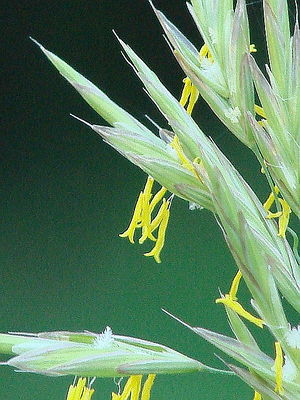Difference between revisions of "Bromus sitchensis var. carinatus"
(→Taxonomy) |
|||
| Line 41: | Line 41: | ||
*''Bromus virens'' var. ''minor'' Scribn. ex Beal | *''Bromus virens'' var. ''minor'' Scribn. ex Beal | ||
}} | }} | ||
| − | + | <ref>Integrated Taxonomic Information System. Retrieved from https://www.itis.gov/servlet/SingleRpt/SingleRpt?search_topic=TSN&search_value=40520</ref> | |
==Description== | ==Description== | ||
Revision as of 23:59, 17 March 2021
- Latin Name: Bromus sitchensis var. carinatus
- Family: Poaceae
- Common Names: California brome
- Synonyms/Misapplications: Bromus carinatus, Ceratochloa carinata
- Codon: BROSIT
Contents
Taxonomy
| Bromus carinatus | |
|---|---|

| |
| Photo by Craig Althen, 2015. Also featured on Main Page | |
| Scientific classification | |
| Kingdom: | Plantae |
| Subkingdom: | Viridiplantae |
| Phylum: | Tracheophyta |
| Subphylum: | Spermatophytina |
| Class: | Magnoliopsida |
| Order: | Poales |
| Family: | Poaceae |
| Genus: | Bromus L. |
| Species: | Bromus carinatus Hook. & Arn. |
| Synonyms | |
| |
Description
Perennial It is hardy to zone 0. The flowers are hermaphrodite (have both male and female organs) and are pollinated by Flies, bees, beetles. The plant is self-fertile. The plant prefers light (sandy), medium (loamy) and heavy (clay) soils and requires well-drained soil. The plant prefers acid, neutral and basic (alkaline) soils. It can grow in semi-shade (light woodland) or no shade. It requires moist soil.
Bloom Period
Distribution
Habitat
Uses
Propagation
Seed
Seed sample from: 2008
Average measurement: 14.6 x 1.5 x 1.5
Measurement range: L: 13.5 – 16 W: 1.1 – 1.8 D: 1.2 - 2
Features
Shape: Inner seed is about ½ the size of its husk, and brown.
Color:Seed husk tan, tending to be whiter toward hilium, and browner towards awn.
Surface:Hilium is somewhat glossy, while rest of husk is very hairy. Awn is brown and straight. Surface of seed longitudinally striate and glossy.
Latitudinal cross section: elliptical 
Longitudinal cross section: elliptical ![]()
Basic Explanations and Assumptions:
The dimensions for the seeds are length x width x depth. The location of the hilum is used as the base of the seed, and the length is measured from hilum to the opposite apex. Where a style is present, the length is measured from the hilum to the bottom of the style. Width is measured at a right angle to the length at the widest part. Depth is measured at a right angle to the intersection of height and width lines.
Measurements included are the mean average for each measurement of ten separate seeds.
All measurements in millimeters unless otherwise noted.
Photo Gallery
References
- ↑ Integrated Taxonomic Information System. Retrieved from https://www.itis.gov/servlet/SingleRpt/SingleRpt?search_topic=TSN&search_value=40520





